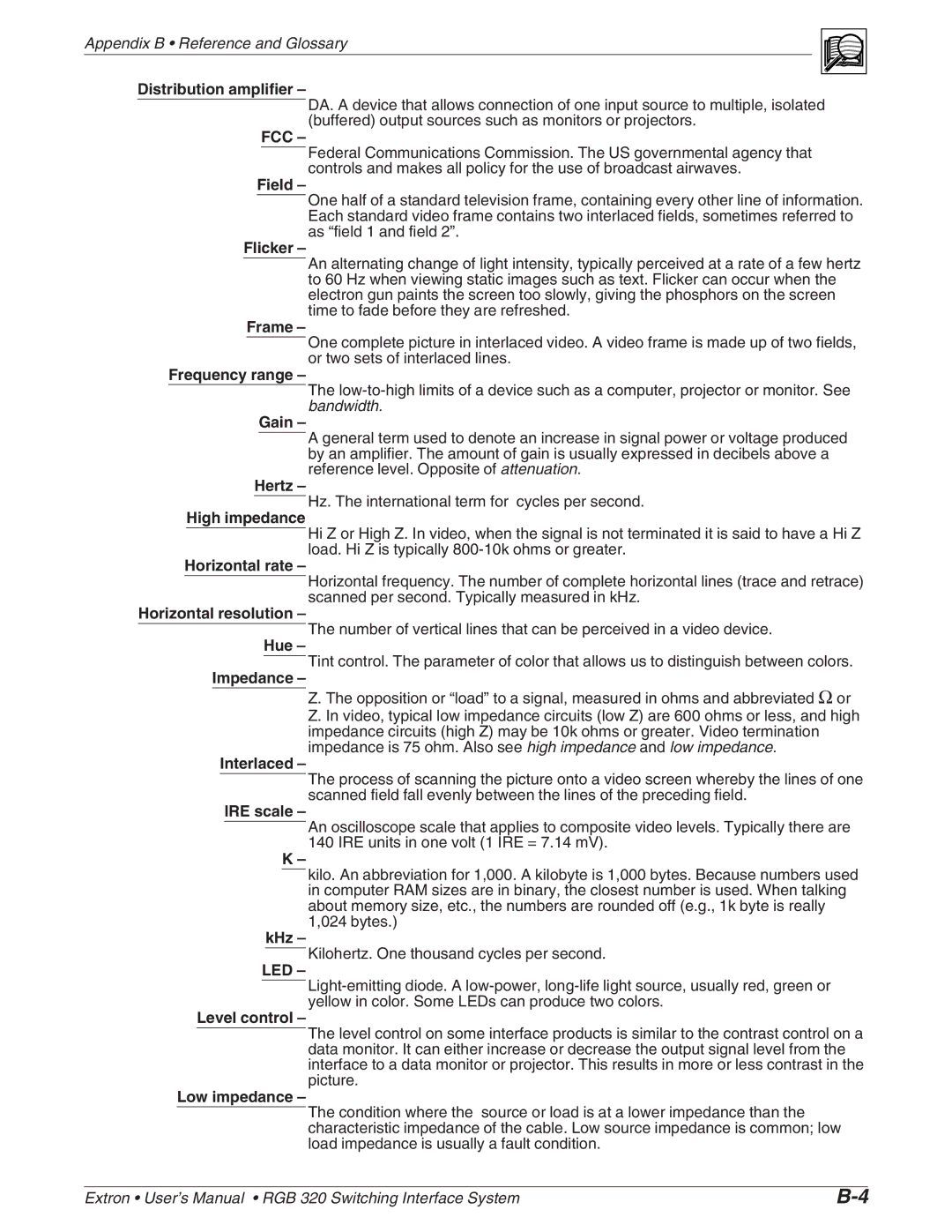
Appendix B • Reference and Glossary
Distribution amplifier –
DA. A device that allows connection of one input source to multiple, isolated (buffered) output sources such as monitors or projectors.
FCC –
Federal Communications Commission. The US governmental agency that controls and makes all policy for the use of broadcast airwaves.
Field –
One half of a standard television frame, containing every other line of information. Each standard video frame contains two interlaced fields, sometimes referred to as “field 1 and field 2”.
Flicker –
An alternating change of light intensity, typically perceived at a rate of a few hertz to 60 Hz when viewing static images such as text. Flicker can occur when the electron gun paints the screen too slowly, giving the phosphors on the screen time to fade before they are refreshed.
Frame –
One complete picture in interlaced video. A video frame is made up of two fields, or two sets of interlaced lines.
Frequency range –
The
Gain –
A general term used to denote an increase in signal power or voltage produced by an amplifier. The amount of gain is usually expressed in decibels above a reference level. Opposite of attenuation.
Hertz –
Hz. The international term for cycles per second.
High impedance
Hi Z or High Z. In video, when the signal is not terminated it is said to have a Hi Z load. Hi Z is typically
Horizontal rate –
Horizontal frequency. The number of complete horizontal lines (trace and retrace) scanned per second. Typically measured in kHz.
Horizontal resolution –
The number of vertical lines that can be perceived in a video device.
Hue –
Tint control. The parameter of color that allows us to distinguish between colors.
Impedance –
Z. The opposition or “load” to a signal, measured in ohms and abbreviated or
Z. In video, typical low impedance circuits (low Z) are 600 ohms or less, and9high impedance circuits (high Z) may be 10k ohms or greater. Video termination impedance is 75 ohm. Also see high impedance and low impedance.
Interlaced –
The process of scanning the picture onto a video screen whereby the lines of one scanned field fall evenly between the lines of the preceding field.
IRE scale –
An oscilloscope scale that applies to composite video levels. Typically there are 140 IRE units in one volt (1 IRE = 7.14 mV).
K –
kilo. An abbreviation for 1,000. A kilobyte is 1,000 bytes. Because numbers used in computer RAM sizes are in binary, the closest number is used. When talking about memory size, etc., the numbers are rounded off (e.g., 1k byte is really 1,024 bytes.)
kHz –
Kilohertz. One thousand cycles per second.
LED –
Level control –
The level control on some interface products is similar to the contrast control on a data monitor. It can either increase or decrease the output signal level from the interface to a data monitor or projector. This results in more or less contrast in the picture.
Low impedance –
The condition where the source or load is at a lower impedance than the characteristic impedance of the cable. Low source impedance is common; low load impedance is usually a fault condition.
Extron • User’s Manual • RGB 320 Switching Interface System |
